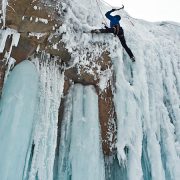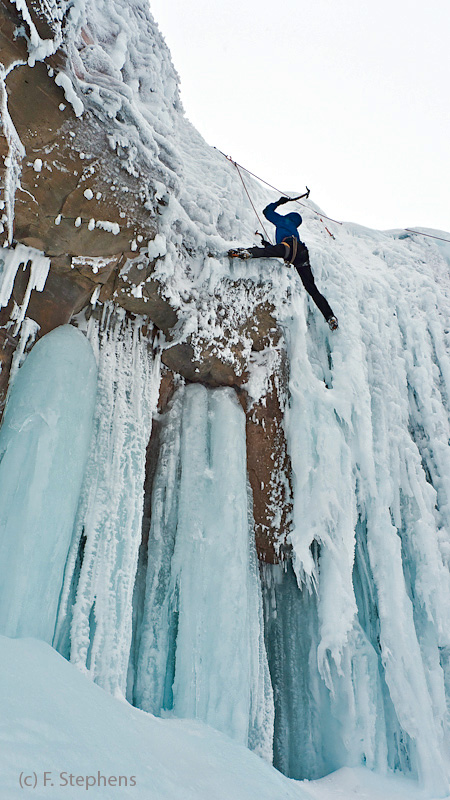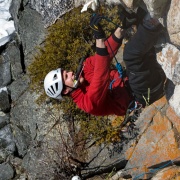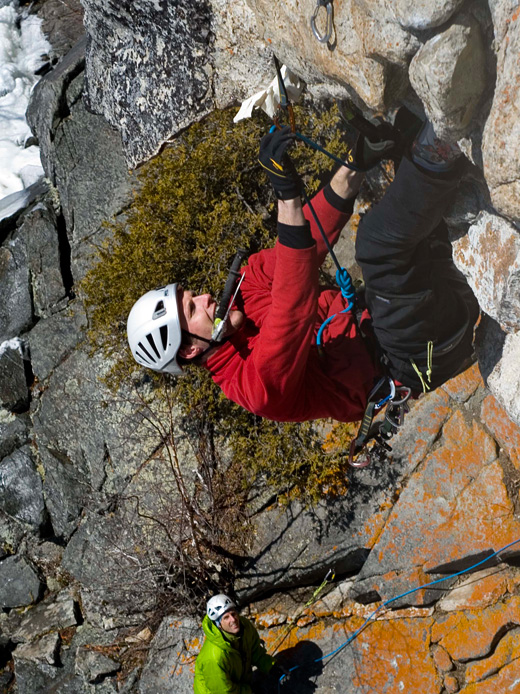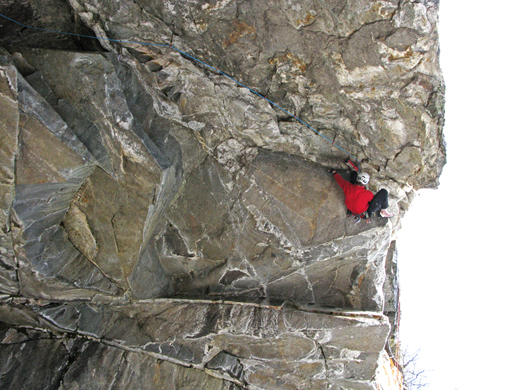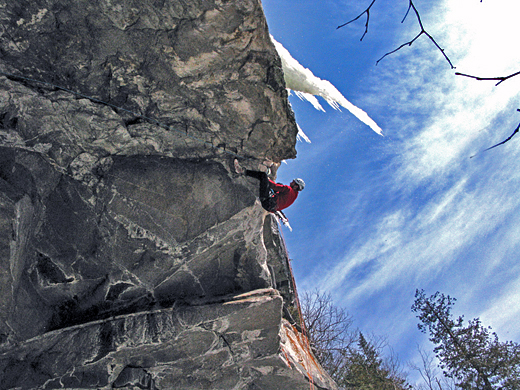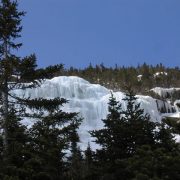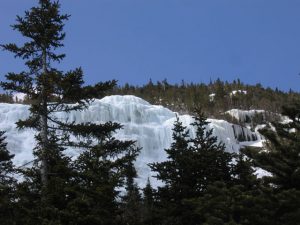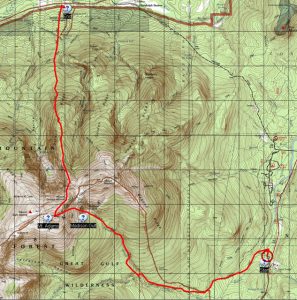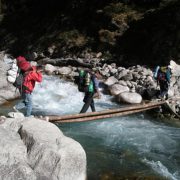The Trifecta
Pinnacle, Shoestring and The Throat in a day
By Alan Cattabriga

The Details:
1. Pinnacle: Leave Car 6am, Back down 9:15am. (3hrs. 15min.)
2. Shoestring: Leave car 10:20am, Back down 12:10 (1hr.50min.)
3. The Throat: Leave car 1pm, Back down 5:50pm. (5hrs.50min.)
Total Time: 10 hrs. 55 min.
Total Distance: 16.07 Miles
Total Elevation Gain: 7613 ft
The Story….The Adirondack climbers had the cool name, “The Trilogy”, damn it!! I grew up reading Tolkien, my other main staple in my youth was Castaneda, a load of killer titles, but the “collection” of books had no name. Good thing they did not, for I don’t think I could ever climb as many alpine routes in a day as Carlos has books. But “Trifecta”, now there is a sweet sounding word. A word that can be applied to a few different activities…..Of testing the legs and getting some times;In Jan ’08, Ted Hammond & I did a Shoestring/Lincoln’s Throat combo. It took us like 11hrs; Shoestring went like clock work but the approach to the Throat was hideous, with deep snow and the stream open here & there. In one of the “here” portions I took a little dip. We also lost some time for we wanted to do a unknown left finish to the Franconia Ridge that leaves the main drainage before the Throat, but we took our turn too soon (my fault) and after a long, cool gully, it dead ended at a spruce wall that resembled the Spartan spears in the movie 300. We descended the gully (I was really pissed at my faux pas) and motored up to the Mullet (right slab) line to Lincoln’s summit and enjoyed an awesome sunset. Our mistake took time but gave us a huge sunset gift.
This past Dec. I dabbled again, this time with Damnation, descending Lion’s Head then Shoestring combo. I kept my pace at a slow boil in the ravine, but being alone I went hard on Shoestring and took 20mins. of my fastest time there. (6.5 hrs. total time.)The ice season comes full circle every year, we start & end in the alpine zone, time to stop thinking and start doing. The second wk. of March had started, conditions in the zone were looking good. The next few days were going to be sunny and nights cold. My day was going to be Friday the 13th. Worry? Why should I? I’m not superstitious, though the last time I took this date off, I augured into the ground off of Omega’s first pitch and got totally owned.Of the Trifecta: Pinnacle Gully, Shoestring Gully & Lincoln’s Throat;I’m up early Fri. morning and leave the house at 3:45am. I’ve gone over the times I want to do each section and the best way to do this. For the ravine portion, the fastest way would be Pinnacle then down South. I leave the car in Pinkham at 6am. The moon was just starting to wan and low, but lit the trail nicely.
I get to the ravine just as the sun is lighting up the headwall, it’s cold, single digits and a bit windy but bluebird. I hear the sound of a snowmobile coming and talk with avy ranger, Justin, as I get ready. The snow in the Fan is glazed and rock hard, Pinnacle looks beautiful. The ice was hard and brittle, with thin cracks/lines running this way and that. Because of these cracks my tools were breaking off triangular chunks which made tool placements kind of a pain. After the first 200′ the rest of the climb is hard, ice covered snow. Total fun, single tool climbing. I’m down South Gully fast, remove the ‘poon’s and jog the trail down.I find the snow absolutely perfect on the approach to Shoestring. So hard, I put the crampons on as soon as I started going up in the woods. The gully was in great condition and the direct finish awesome. The Webster Cliff Trail was very hard snow and crampons would have been the ticket, but I wanted to jog down so I took them off. After the first steep sections, and a few borderline out of control glissades, the rest of the trail was nice. It was now 11:50 and I wanted to start the approach to the Throat by 1 to stay on time. Perfect..
Now I thought the driving parts would be great, time to refuel, crank some Dead, take the boots off, give the feet a break and it was…. but when I got out at Lincoln’s parking, my legs had stiffened up pretty bad. It took a fair amount of hiking to loosen them again. Even though the snow conditions had been great, I decided to bring the snowshoes, I did not want to get into the Lincoln’s approach drainage and have a posthole party.
The Old Bridle Path was good & packed, I put the shoes on for the steep bushwhack down to the Throat’s drainage. Once there I discovered a gift – two people had gone up earlier and broken the hard crust. I removed the shoes and followed their tracks. The going was good and eventually the snow hard enough to stay on top. The Throat was fat and I climbed it right of the usual ice hose, the snow above the ice was excellent. On Lincoln’s summit there was a light wind and I could see for miles. I’m stoked!! While digging the views I drink a Red Bull and eat the last of a cookie & Balance bar. It’s 4pm and time to go, the Franconia Ridge to Little Haystack was all ice and hard snow, very nice. The hike down the Falling Waters Trail was packed, hard snow so I keep the ‘poons on almost the whole way down. I got back to the car just shy of 12hrs. (10hrs of total hiking/climbing) after starting in Pinkham… A phone call home and the next stop is the nearest beer store.
I drink a Red Bull and eat the last of a cookie & Balance bar. It’s 4pm and time to go, the Franconia Ridge to Little Haystack was all ice and hard snow, very nice. The hike down the Falling Waters Trail was packed, hard snow so I keep the ‘poons on almost the whole way down. I got back to the car just shy of 12hrs. (10hrs of total hiking/climbing) after starting in Pinkham… A phone call home and the next stop is the nearest beer store. There are many link-ups one can do around here. Adding Adams Slide on Cannon to what I did would be very doable. For this linky I thought of the car as a base camp and I could keep my pack light, once above tree line I had on all I brought for cloths, a little food and 1 pint of Gatorade per section, except on the Throat, I had only about 8oz. left and the Bull.
There are many link-ups one can do around here. Adding Adams Slide on Cannon to what I did would be very doable. For this linky I thought of the car as a base camp and I could keep my pack light, once above tree line I had on all I brought for cloths, a little food and 1 pint of Gatorade per section, except on the Throat, I had only about 8oz. left and the Bull.
Come to find out The “Trilogy” got sent about the same time as my day by Joe Szot & and a friend. Awesome! Then Emilie Drinkwater repeats it a few days later, solo. Yeah, totally awesome.. To be out there, a long day, alone takes some fortitude, but the feeling you get……Now I’m in no way am thinking that I’m the first person to do this link-up. I’ve never heard of it being done though, it was a test just for me.AlanMore Links ……..Lincoln’s Throat – Mt. Lincoln – eguide on NEicePinnacle Gully – eguide on NEiceThe Throat– Photo search on NEicePinnacle– Photo search on NEiceShoestring – Photo search on NEicePhotos & content by Alan Cattabriga, maps, links and web page by Doug Millen

